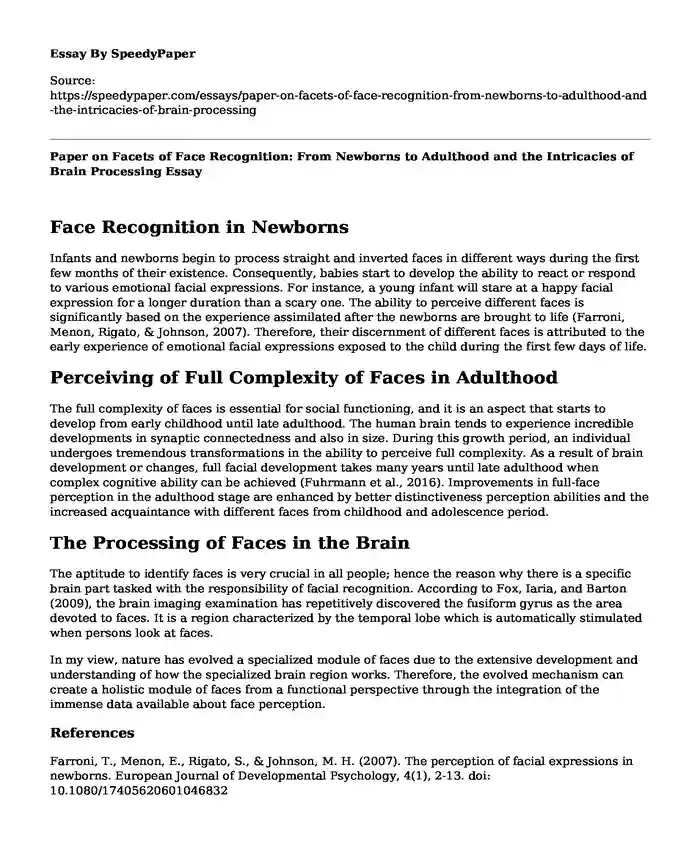
| Type of paper: | Essay |
| Categories: | Child development Childhood Development |
| Pages: | 2 |
| Wordcount: | 437 words |
Face Recognition in Newborns
Infants and newborns begin to process straight and inverted faces in different ways during the first few months of their existence. Consequently, babies start to develop the ability to react or respond to various emotional facial expressions. For instance, a young infant will stare at a happy facial expression for a longer duration than a scary one. The ability to perceive different faces is significantly based on the experience assimilated after the newborns are brought to life (Farroni, Menon, Rigato, & Johnson, 2007). Therefore, their discernment of different faces is attributed to the early experience of emotional facial expressions exposed to the child during the first few days of life.
Perceiving of Full Complexity of Faces in Adulthood
The full complexity of faces is essential for social functioning, and it is an aspect that starts to develop from early childhood until late adulthood. The human brain tends to experience incredible developments in synaptic connectedness and also in size. During this growth period, an individual undergoes tremendous transformations in the ability to perceive full complexity. As a result of brain development or changes, full facial development takes many years until late adulthood when complex cognitive ability can be achieved (Fuhrmann et al., 2016). Improvements in full-face perception in the adulthood stage are enhanced by better distinctiveness perception abilities and the increased acquaintance with different faces from childhood and adolescence period.
The Processing of Faces in the Brain
The aptitude to identify faces is very crucial in all people; hence the reason why there is a specific brain part tasked with the responsibility of facial recognition. According to Fox, Iaria, and Barton (2009), the brain imaging examination has repetitively discovered the fusiform gyrus as the area devoted to faces. It is a region characterized by the temporal lobe which is automatically stimulated when persons look at faces.
In my view, nature has evolved a specialized module of faces due to the extensive development and understanding of how the specialized brain region works. Therefore, the evolved mechanism can create a holistic module of faces from a functional perspective through the integration of the immense data available about face perception.
References
Farroni, T., Menon, E., Rigato, S., & Johnson, M. H. (2007). The perception of facial expressions in newborns. European Journal of Developmental Psychology, 4(1), 2-13. doi: 10.1080/17405620601046832
Fox, C. J., Iaria, G., & Barton, J. J. (2009). Defining the face processing network: Optimization of the functional localizer in fMRI. Human Brain Mapping, 30(5), 1637-1651. doi:10.1002/hbm.20630
Fuhrmann, D., Knoll, L. J., Sakhardande, A. L., Speekenbrink, M., Kadosh, K. C., & Blakemore, S. -. (2016). Perception and recognition of faces in adolescence. Scientific Reports, 6(1). doi: 10.1038/srep33497
Cite this page
Paper on Facets of Face Recognition: From Newborns to Adulthood and the Intricacies of Brain Processing. (2023, Dec 25). Retrieved from https://speedypaper.net/essays/paper-on-facets-of-face-recognition-from-newborns-to-adulthood-and-the-intricacies-of-brain-processing
Request Removal
If you are the original author of this essay and no longer wish to have it published on the SpeedyPaper website, please click below to request its removal:
- Test Answers Example on Freud's Psychosexual Theory and Erikson's Psychosocial Developmental
- Free Essay: Children from Their Parents and Place in Foster Care
- Essay Sample on How Much Freedom Should Parents Give to Their Children?
- Paper Example. Rome as an Empire and a Republic
- Research Proposal Example on Childhood Obesity
- Reflection on the Coronavirus - Free Paper Sample
- Pediatric Health: Assessments and Conditions Overview - Report Sample
Popular categories




